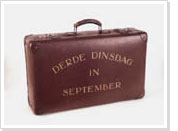The state treasury chest > From the cradle to the grave the Netherlands as progressive welfare state (1945 up to now)
 After the war, the country’s reconstruction was taken to hand with might and main. The Minister of Finance, P. Lieftinck, implemented a radical monetary reform policy swiftly and efficiently. Thanks to the American Marshall Plan, the Netherlands were able to obtain sorely needed money loans, so that the economy could make a speedy recovery in the 1950s.
After the war, the country’s reconstruction was taken to hand with might and main. The Minister of Finance, P. Lieftinck, implemented a radical monetary reform policy swiftly and efficiently. Thanks to the American Marshall Plan, the Netherlands were able to obtain sorely needed money loans, so that the economy could make a speedy recovery in the 1950s.
The Dutch welfare state was built up in the 1960s and 1970s. All sorts of provisions were created in the fields of education, care for the elderly, public health and social security. A hefty price tag is attached to the welfare state for providing all inhabitants of the Netherlands with securities of all sorts, from the cradle to the grave.
Prior to 1940, state expenditures amounted to less than the equivalent of 0.5 billion euros per annum. Twenty years later, they had risen to some 5 billion euros and at the end of the 20th century, they amounted to some 90 billion euros. Next to the revenues from state enterprises, public loans, natural gas and social security contributions, taxes form the lion’s share of the national income.
Nowadays, the Tax Department rakes in some 115 billion euros in taxes and some 76 billion in social security contributions for the state.
Back to A short history of taxation.
